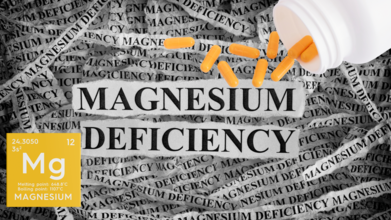- Health Conditions A-Z
- Health & Wellness
- Nutrition
- Fitness
- Health News
- Ayurveda
- Videos
- Medicine A-Z
- Parenting
- Web Stories
After 19 Years Of Infertility And 15 Failed IVF Attempts, Breakthrough AI Procedure Helps Woman Conceive

After years of trying, what happens when hope feels like it's slipping away? That’s exactly where Rosie and her husband found themselves—staring down nearly two decades of infertility and 15 failed IVF cycles but just when they had exhausted every known option, a cutting-edge AI tool offered a new kind of possibility. This isn’t the story of another treatment attempt—it’s the story of a medical breakthrough that’s redefining what’s possible for couples facing male infertility. Could AI finally be the game-changer reproductive medicine has been waiting for?
In a world where infertility often feels like a lifelong sentence for couples, a revolutionary AI-based technology has made what once seemed impossible — possible. At Columbia University Fertility Center, a couple's two-decade-long struggle with infertility was finally brought to an end, not by chance or conventional medicine, but by a machine. The result? A historic pregnancy — the first ever achieved using a groundbreaking artificial intelligence system named STAR (Sperm Track and Recovery).
For 38-year-old Rosie and her husband, this wasn’t just a clinical success story — it was the fulfillment of a dream that had slipped through their fingers for nearly 19 years. With 15 failed IVF attempts behind them and a diagnosis of male infertility due to azoospermia, they had begun to lose hope. But an AI system inspired by astrophysics offered them — and many others — a new lease on fertility.
Male infertility contributes to around 40% of all infertility cases, and azoospermia — the absence of detectable sperm in semen — accounts for about 10% of these. Until recently, azoospermia was almost a dead-end diagnosis. Options were limited to sperm donors or invasive surgeries with low success rates and significant physical and emotional tolls.
The traditional process of sperm detection relied heavily on the trained eyes of embryologists painstakingly examining semen samples for hours or even days. Even after exhaustive efforts, in many cases, no sperm would be found. That’s where the STAR system marks a dramatic shift.
How The AI Procedure Works?
The innovation at the heart of this breakthrough, STAR was developed by Dr. Zev Williams and his team over five years. The AI tool combines an algorithm with a fluidic microchip that scans millions of cells at lightning speed. When rare sperm cells are detected, the system diverts and isolates them for use in fertilization.
This method mirrors astronomical AI tools used to detect new stars in the sky — now applied to fertility science. The STAR system can analyze up to 8 million images in an hour, far outpacing human capability.
In one extraordinary test, where embryologists failed to find a single sperm after two full days of manual analysis, STAR identified 44 sperm in less than 60 minutes.
What’s equally remarkable is that Rosie’s successful pregnancy required no new or additional IVF protocols. The fertilization process followed the standard IVF timeline, eggs retrieved from Rosie were fertilized using sperm isolated by STAR. Within two hours, the team confirmed successful fertilization.
Now four months pregnant, Rosie reflects on the surreal nature of her experience. “I still wake up in the morning and can’t believe this is real,” she says. “I kept my expectations low because after so many failures, I couldn’t handle another heartbreak. But this was different.”
Rosie and her husband had not taken their journey lightly. Grounded in their Orthodox Jewish faith, they persisted through emotional trials, surgeries, and consultations with specialists from across the globe. Their search for answers even led them to controversial chemical-based methods that ultimately yielded no success.
The introduction to STAR came via a community support group. With deep curiosity and cautious optimism, they engaged with Dr. Williams’ team. “We knew what STAR was trying to do. It gave us hope that sperm could be found without invasive methods or chemicals,” says Rosie.
Unlike past IVF attempts, the STAR-assisted cycle required no extra testing or procedure changes. The simplicity and precision of the technology proved transformative.
While this marks a milestone in fertility treatment for azoospermia, Dr. Williams believes it’s just the beginning. “There are things going on that we are blind to right now,” he explains. “But with AI, we’re finally seeing those blind spots. This could open the door for many couples told they had no chance.”
STAR represents a paradigm shift. Not only does it detect sperm, but it actively isolates them — a dual function that sets it apart from existing AI tools that only detect without collecting. This innovation allows even the rarest viable sperm to be collected in real-time for immediate use or future preservation.
In the clinical process, doctors use multiple semen samples to maximize the chance of success. Sperm isolated by STAR are frozen ahead of time, and a fresh sample is processed on the day of egg retrieval. This layered approach ensures backup options if no sperm are detected in the fresh sample.
In Rosie’s case, the system worked efficiently. Her husband’s sperm was collected, STAR located viable sperm, fertilization occurred the same day, and the embryos were transferred just days later.
“Usually in IVF cycles, we have more sperm than eggs,” says Dr. Williams. “But with azoospermia, it’s the opposite. STAR flips that equation.”
What This Means For Future Fertility Treatment?
While this pregnancy was a first, it signals a sea change in how science approaches male infertility. The Columbia team hopes to expand the use of STAR, refine its algorithm, and eventually use AI in tackling female infertility and other complex reproductive challenges.
With each cycle, each image scanned, and each isolated cell, STAR gives voice to a quiet revolution in reproductive health — one driven by technology, empathy, and unwavering human resolve.
Rosie’s journey — filled with patience, faith, and scientific innovation — stands as a testament to the potential of AI in medicine. As she continues her pregnancy, she remains cautiously optimistic, grateful, and hopeful that this technology will bring joy to countless others.
“I’m still in awe,” she says. “But if STAR worked for us, it can work for others too. It’s hope in a chip.”
This Thing In Your Hair Could Heal Your Tooth Enamel And Keep Them Pearly White

Credits: Canva
The search for stronger, longer-lasting teeth has been a cornerstone of dentistry. From the widespread use of fluoride to modern resin fillings, the field has steadily advanced but has never managed to replicate the extraordinary natural material that coats our teeth: enamel. Once it erodes, it’s gone forever—or at least, that’s what we’ve always believed.
Now, researchers from King’s College London are challenging this assumption with an unusual but promising source: keratin, the protein that makes up human hair and animal wool. Their findings suggest that something as simple as a haircut could one day contribute to regenerating tooth enamel and transforming oral care.
Why Tooth Enamel Is Irreplaceable?
Tooth enamel may look simple—a hard, shiny coating that gives teeth their strength and luster—but it is one of the most remarkable substances in the human body. Harder than bone, enamel is designed to withstand decades of grinding, chewing, and exposure to temperature extremes.
Unlike bone, however, enamel is non-living. It lacks the cells and blood supply necessary to heal itself. That’s why a small cavity or a patch of erosion, if left untreated, can become a permanent problem. Once enamel wears away, it exposes dentin, a softer layer that appears yellow and is far more vulnerable to decay.
The impact of enamel erosion is staggering. Dental decay weakens a tooth’s strength by up to 95 percent, leaving it prone to fractures, sensitivity, and eventually loss. According to the Global Burden of Disease 2019, untreated cavities affect an estimated two billion people worldwide, making dental decay the most common disease on the planet.
What Are The Limitations of Current Dental Treatments?
Modern dentistry has developed tools to slow or mask the damage caused by enamel loss, but not to restore it. Fluoride can strengthen remaining enamel and delay erosion, but it cannot rebuild what has already vanished. Resin-based fillings, while effective in patching cavities, are no match for the natural durability and resilience of enamel. Worse still, resins can contain toxic compounds and lack the long-term strength of natural tooth material.
The result is a cycle of temporary fixes. Cavities are filled, fillings fail, larger restorations follow, and eventually, teeth are lost. As populations age and diets grow increasingly sugar-heavy, the financial and health burden of this cycle is enormous. The challenge has been clear: how can dentistry move beyond patchwork solutions to true biological regeneration?
How Does A Hair Protein Improve Your Teeth?
The answer may lie in keratin, the fibrous protein best known for forming hair, nails, and wool. In their study, researchers at King’s College London extracted keratin from sheep wool and introduced it into a solution designed to mimic human saliva. To their surprise, the keratin didn’t simply dissolve or degrade—it began pulling minerals from the artificial saliva and assembling them into structures that closely resembled natural tooth enamel.
The regenerated material didn’t just look like enamel under a microscope; it behaved like enamel, too. It demonstrated the same stiffness, resistance to wear, and pearly shine that makes natural teeth so resilient.
What’s more, the team discovered that mixing different types of keratin produced superior results. By layering proteins in a hierarchical structure—similar to Russian nesting dolls—they achieved enamel-like material with remarkable strength, durability, and resistance to various forms of degradation.
Attempts to regrow enamel are not new. Previous efforts have focused on peptides, stem cells, and synthetic biomaterials. Yet these approaches have often stumbled over practical barriers, from poor bioavailability to the inability to repair deep cavities.
Keratin may offer a way around these roadblocks. It is abundant, renewable, and can be sourced from waste materials like wool or hair, aligning with a circular economy model. Unlike synthetic resins, keratin-based materials are biocompatible and less likely to trigger toxicity or rejection.
As Dr. Sherif Elsharkawy, the study’s senior author, put it: “We are entering an exciting era where biotechnology allows us to not just treat symptoms but restore biological function using the body’s own materials.”
While the concept might sound futuristic, researchers believe keratin-based enamel boosters could be available within two to three years. Potential applications range from everyday products like toothpaste to more targeted dental gels applied by clinicians.
Imagine visiting your dentist not for a drill-and-fill appointment but for a keratin “varnish” that coats your teeth, hardening over time into new enamel. Or brushing daily with a toothpaste that rebuilds microscopic enamel loss before it develops into a cavity.
If successful, these products could revolutionize dental care by shifting the focus from repair to regeneration.
The implications stretch far beyond whiter smiles. Dental decay is a leading cause of pain, disability, and lost productivity worldwide, especially in low-resource settings where access to dental care is limited. A safe, affordable way to restore enamel could dramatically reduce the burden of oral disease across populations.
The study, published in Advanced Healthcare Materials, is still in early stages. Researchers must test keratin-based enamel in real-world conditions, ensuring it can withstand the stresses of chewing, exposure to bacteria, and years of daily use. Clinical trials will be critical before any commercial rollout.
Still, the concept is generating excitement as co-author Elsharkawy noted, “With further development and the right industry partnerships, we may soon be growing stronger, healthier smiles from something as simple as a haircut.”
Indonesia Launches Mass Vaccination Drive After Deadly Measles Outbreak

Credits: Canva
Hundreds of children lined up at health centers in East Java on Monday as Indonesia began a mass vaccination drive to curb a deadly measles outbreak that has claimed 17 lives in recent months. The campaign, which targets tens of thousands of young children, comes amid concerns over low vaccination coverage in the world’s fourth most populous nation.
Outbreak Hits East Java Hard
According to the Sumenep District Health Agency, more than 2,000 children have been infected with measles in East Java over the past eight months. Sixteen of the 17 deaths were reported in Sumenep district, where officials revealed that none of the patients had received complete measles immunization.
Deputy chief of Sumenep district Imam Hasyim urged parents to ensure their children receive the shots. “Otherwise, this disease, measles, will spread further among our children. It will be even more fatal in the future,” he said. Authorities are aiming to vaccinate 78,000 children aged between nine months and six years as part of the emergency drive.
What Is Measles?
Measles is a highly contagious viral disease that spreads through coughing, sneezing, or direct contact with an infected person. Symptoms often start with a high fever, cough, runny nose, and red eyes, followed by a distinctive red rash that spreads across the body.
While measles may seem like a childhood illness, it can cause severe complications such as pneumonia, brain inflammation, blindness, and even death. The World Health Organization (WHO) warns that measles is among the leading causes of death among young children globally, despite the availability of a safe and effective vaccine.
Past Outbreaks in Indonesia
This is not Indonesia’s first struggle with measles outbreaks. In 2018, the eastern province of Papua experienced a major outbreak that killed dozens. At the time, vaccination efforts faced hurdles when the Indonesian Ulema Council announced that the measles-rubella vaccine contained pork derivatives. While authorities permitted temporary use of the vaccine made by India’s Serum Institute, vaccination rates dropped as debates over halal certification grew.
Last year, only 72% of Indonesia’s 22 million children under the age of five received the measles vaccine, according to government statistics. In some provinces, coverage fell below 50%, far short of the 95% rate needed to prevent outbreaks.
Global Concern Over Measles Resurgence
The outbreak in Indonesia mirrors a troubling global trend. WHO reported that 60 countries experienced major measles outbreaks in 2023. Worldwide, about 84% of children received their first dose of the vaccine and 76% got the recommended second dose. Public health experts, however, stress that vaccination rates must be significantly higher to achieve herd immunity.
In the United States, the Centers for Disease Control and Prevention (CDC) recently reported the highest number of measles cases in over 30 years. Similar outbreaks have been recorded across Europe, Africa, and Latin America, underscoring how quickly the virus can spread when immunization coverage declines.
Authorities Call for Collective Action
Indonesian officials have appealed to local leaders, community groups, and religious authorities to encourage participation in the vaccination campaign. Given the sensitivity around vaccine ingredients in the past, their role is considered vital in restoring public trust.
Health experts stress that strengthening immunization programs is critical for Indonesia’s future. With millions of children still vulnerable, they warn that outbreaks will continue unless vaccine coverage improves substantially.
As the latest campaign rolls out, parents like those in Sumenep are being urged to prioritize their children’s protection. For many, this mass drive could mean the difference between life and death.
The Most Dangerous Sign Your Body Is Starving for Magnesium

Credits: Canva
People pop supplements to sleep better, soothe their nerves, or stop those calf cramps. But what if we told you that the most dangerous consequence of low magnesium is not about tossing and turning or having twitchy legs at all?
According to nutritionist Dr Eric Berg, also known as the Knowledge Doc, the real red flag is something far scarier and far more life-altering.
It’s Not About Cramps, Stress, or Palpitations
When you think of magnesium deficiency, the usual problems that come to mind are cramping muscles, restless nights, and that fluttery feeling in your chest. Sure, they are uncomfortable. But as Dr. Eric Berg explains:
“The most dangerous symptom of a magnesium deficiency is not muscle cramps, it's not anxiety or insomnia, and it's not heart palpitations. Those are warning signs of the silent red flag behind 80% of all chronic diseases. If you ignore it, it won't just disrupt your health; it will literally cause disease because it's at the heart of so many health problems.”
Then, what is this “silent red flag”? According to Dr. Berg:
“The most dangerous symptom of a magnesium deficiency is mitochondrial dysfunction. It's impossible for your mitochondria to make energy without magnesium, and most chronic diseases start with dysfunctional mitochondria.”
Mitochondria are the microscopic “batteries” inside your cells. They’re the power stations that keep your heart pumping, your brain firing, and your muscles moving. Take magnesium out of the equation, and these little energy factories can’t run. Instead of fueling you, they fizzle out, and that’s when disease creeps in.
From Tired Cells to Tired You
When your mitochondria don’t get enough magnesium, it leads to fatigue, brain fog, and slow recovery from workouts, which are just the tip of the iceberg.
But as Dr. Berg says, mitochondrial dysfunction isn’t just about feeling drained; it’s linked to heavy hitters like cancer, Alzheimer’s, Parkinson’s, type 2 diabetes, and high blood pressure. That means something as “simple” as a mineral deficiency could be a silent trigger for some of the most feared diseases of our time.
Are You Missing the Signs?
Magnesium deficiency is alarmingly common, thanks to modern diets and stress-filled lifestyles. Coffee, alcohol, processed foods, and even certain medications can quietly deplete your magnesium reserves. While you might brush off cramps or poor sleep as minor annoyances, they could actually be early SOS signals from your mitochondria.
It’s easy to overlook because the symptoms feel ordinary. Who hasn’t had a bad night’s sleep, felt stressed, or battled brain fog? But if these patterns keep repeating, they may be pointing to something bigger beneath the surface.
What You Can Do About It
Unlike complex medical interventions, supporting your mitochondria can start on your plate. Dark leafy greens, nuts, seeds, avocados, and even good-quality dark chocolate are all magnesium-rich options.
Simple lifestyle tweaks, like cutting down on processed foods, managing stress, and keeping caffeine and alcohol in check, also help preserve the magnesium you do have. For those with significant deficiencies, supplementation may be worth discussing with a healthcare provider.
© 2024 Bennett, Coleman & Company Limited

